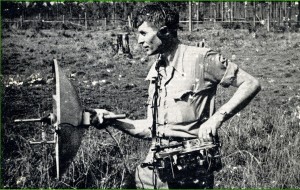None of our museum collections would exist without collectors who go out in the field and bring back specimens to the museum. In many cases faculty, staff and students associated with a collection do field research and collect specimens as part of their projects. In other cases, outside researchers or the public donate specimens to the museum to make their collections available to a wide audience and have them preserved for many years to come.
In the case of the Borror lab, faculty, staff and students as well as outside donors have contributed to the growth of the archive of animal sound recordings.
Here are some of the top ten collectors:
Don Borror, founder of the lab and late professor of Entomology and Zoology at OSU, recorded the songs of many insects and birds as part of his research and teaching as well as his personal interest in the natural world. He has contributed the most recordings with more than 14,000 over a period of 50 years. Don recorded animals using some of the earliest sound recording equipment available, reel-to-reel tapes starting in the late 1940s. His tapes were digitized as part of a project funded by the National Science Foundation to preserve the recordings. We now use some of Don’s recordings, for example, on a CD of insect sounds which is available for purchase from our lab.
Former lab curator Sandy Gaunt traveled to Costa Rica in the early 1990s to record the songs of fourteen species of hummingbirds. Based on recordings of the Green Violetear, one of the colorful metallic green hummingbirds, Sandy and her colleagues suggested that hummingbirds (just like true songbirds) learn their songs. The sound recordings showed that males form neighborhoods of shared distinct song types which vary geographically. Some 200 recordings of hummingbirds are in our archive in addition to recordings of numerous other bird species made by Sandy.
The research of the current director of the Borror lab, Doug Nelson, Associate Professor in EEO Biology, focuses on vocal communication as well as song learning and development. He has recorded many hours of White-crowned Sparrow songs and used these to describe this species’ song dialects along the Pacific Northwest coast. He has added more than 2,000 individual recordings of songs from members of the sparrow family and various seabirds to the archive.
You may know Richard Bradley, Associate Professor emeritus in EEO Biology, for his work on spiders and his recent book Common Spiders of North America which is a must-read for any arachnophile. But Rich shares a great interest in bird song with others in our lab. In fact he started his scientific career describing geographic variation in the song of the Belding’s Savannah Sparrow in California and did research on the song of the Grey-shrike Thrush in Australia. He donated all his recordings to our archive: Over 1,000 recordings from 145 Australian bird species can now be listened to in our archive thanks to Rich.
Recently, Art Borror, son of Don Borror and Professor emeritus from the University of New Hampshire, donated his collection of sound recordings to the lab. He started sound recordings in the late 1950s in Ohio and took a microphone and recorder along on trips for business and vacation. Thus he obtained recordings of birds from places as diverse as Antarctica, Europe and South America.
Follow us on one of Art Borror’s collecting trips with a photo story on this blog on Monday (Nov 16th)!
About the Author: Angelika Nelson is curator of the Borror Laboratory of Bioacoustics; her research interests are in acoustic behavior and female choice in songbirds; she teaches a course on Ohio Birds at OSU each spring.



